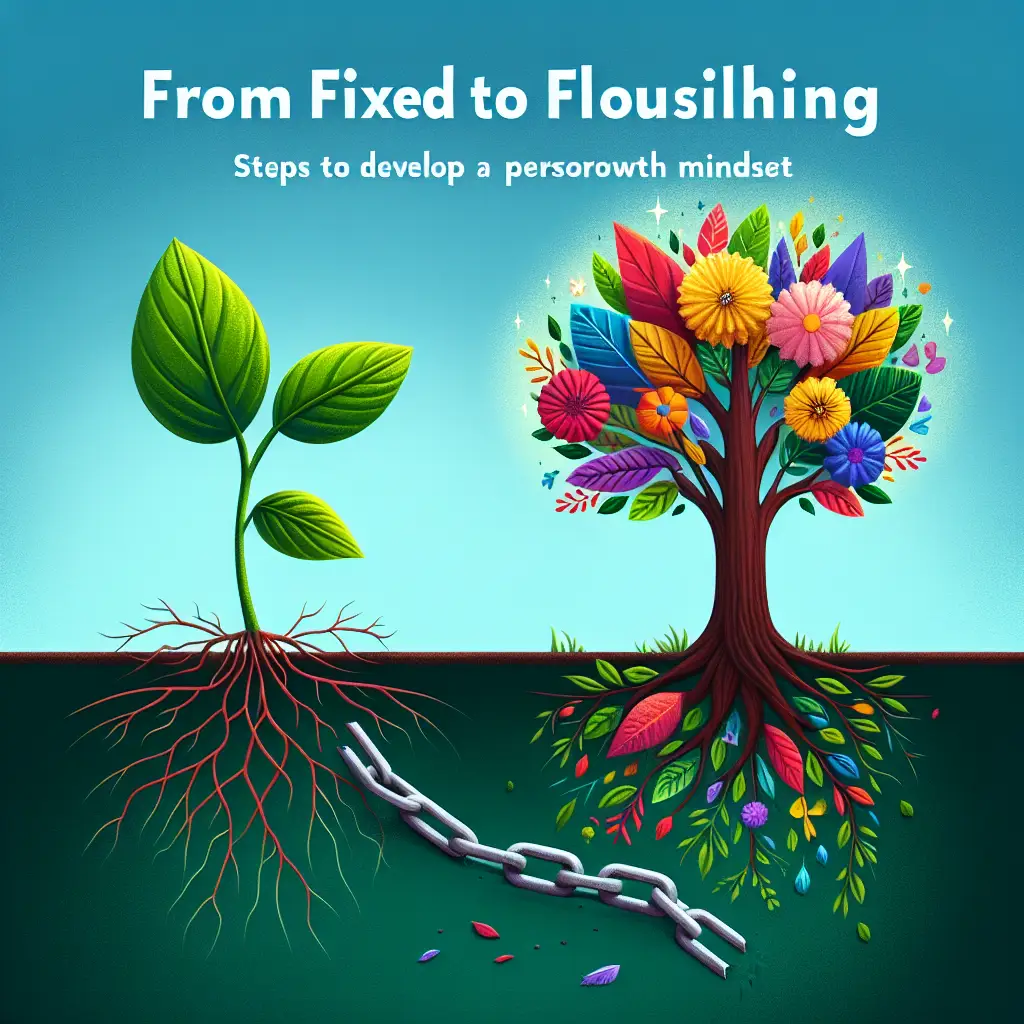
From Fixed to Flourishing: Essential Steps to Develop a Personal Growth Mindset
Introduction
Imagine standing at the edge of a vast forest, a dense canopy of trees surrounding you. With every step you take, the path can twist and turn, offering new challenges and opportunities. In many ways, this metaphor mirrors our journey in life and personal development. As we navigate through our experiences, we encounter setbacks and successes, but everything hinges on how we perceive these moments. This is where the concept of a growth mindset comes into play—transitioning from a fixed mindset, where abilities and intelligence are seen as static, to a flourishing, growth-oriented mental state. In this comprehensive guide, we will explore practical steps to embrace a growth mindset, enabling individuals to overcome challenges, learn from failures, and ultimately thrive.
Understanding Mindsets
What is a Fixed Mindset?
A fixed mindset is a belief that your qualities, such as intelligence and talent, are set traits. Individuals with this mindset often shy away from challenges, feel threatened by criticism, and view effort as fruitless. They tend to stick to what they know, thus limiting their potential for growth.
Case Study: The Study of College Students
In a study conducted by psychologists Carol Dweck and her colleagues at Stanford University, college students demonstrated a range of mindset orientations. Those with a fixed mindset often maintained lower GPAs and were less likely to challenge themselves academically when faced with difficult subjects. This illustrates how a fixed mindset can directly hinder personal and academic growth.
What is a Growth Mindset?
Conversely, a growth mindset is grounded in the belief that abilities and intelligence can be developed through effort, learning, and persistence. Individuals with this mindset are more likely to embrace challenges, persist in the face of setbacks, and view criticism as an opportunity for improvement.
Case Study: The Resilience of Athletes
Consider professional athletes who often undergo rigorous training regimes. For instance, when Olympic swimmers face defeats, those with a growth mindset analyze their performances to identify areas for improvement. This openness to feedback not only drives them to improve but often leads to greater successes.
Steps to Develop a Personal Growth Mindset
Step 1: Embrace Challenges
The Power of Discomfort
The first step in transitioning from fixed to flourishing is to embrace challenges. Growth does not occur in comfort; instead, it arises when we push ourselves beyond our limits.
Practical Tip: Start small. Take on a task outside your comfort zone, whether it’s speaking in public, learning a new language, or tackling a complex project at work. Each small challenge conquered builds resilience.
Step 2: Reframe Failure
Changing the Narrative
Failure is often viewed negatively, yet reframing how we perceive it can dramatically shift our growth trajectory. Instead of viewing failure as an endpoint, see it as a stepping stone towards success.
Case Study: Thomas Edison and the Light Bulb
Edison famously stated that he had not failed, but rather found 10,000 ways that didn’t work before inventing the light bulb. His perspective showcases the essence of embracing failure as part of the learning process, fostering a growth mindset.
Step 3: Cultivate a Learning Environment
Nurturing Curiosity
Surround yourself with people who inspire you, engage in discussions about different viewpoints, and consume diverse knowledge. A learning environment stimulates curiosity and invites exploration.
Tables on Learning Styles
| Learning Style | Description | Example |
|---|---|---|
| Visual | Learning through images and visual aids | Infographics |
| Auditory | Learning through listening | Podcasts |
| Kinesthetic | Learning through doing | Hands-on projects |
Step 4: Develop Positive Self-Talk
Words Shape Reality
Your internal dialogue plays a crucial role in shaping your mindset. Replacing negative self-talk with positive affirmations can improve self-esteem and resilience.
Practical Tip: Replace phrases like “I can’t do this” with “I will approach this step by step.” This shift opens doors to possibilities rather than closing them.
Step 5: Seek Feedback
The Importance of External Perspectives
Feedback is an invaluable tool for personal growth. Embrace constructive criticism rather than viewing it as a personal attack.
Case Study: The Value of Mentor Relationships
Consider a recent study published in the Journal of Applied Psychology that highlights the value of mentorship in professional development. Workers who regularly seek feedback from mentors often report higher job satisfaction and greater career advancement, demonstrating the importance of seeking external viewpoints in developing a growth mindset.
Step 6: Set Learning Goals
Focus on the Journey
Instead of fixating on outcome-based goals, set specific, measurable, achievable, relevant, and time-bound (SMART) learning goals.
Table of SMART Goals
| Goal Type | Description | Example |
|---|---|---|
| Specific | Clearly define the goal | “I will read one book per month” |
| Measurable | Include criteria for measuring progress | “I’ll write a summary for each chapter” |
| Achievable | Set realistic and attainable goals | “I’ll tackle one chapter at a time” |
| Relevant | Ensure it aligns with personal growth objectives | “This book relates to my career development” |
| Time-bound | Deadline for achieving the goal | “I will finish this book by the end of the month” |
Step 7: Practice Resilience
Building Grit
Resilience is the key to finding success in adversity. Cultivating mental endurance fosters a growth mindset and allows you to rise stronger from challenges.
Practical Exercise: Develop a personal resilience checklist that includes stress management techniques such as mindfulness, physical exercise, and maintaining social connections.
Step 8: Celebrate Growth
Recognizing Progress
Celebrating your achievements—big or small—reinforces your growth mindset. Acknowledge the progress you’ve made and the strengths you displayed along the way.
Practical Tip: Maintain a journal where you both document challenges faced and victories achieved. Regularly revisit this journal to reflect on your growth journey.
Conclusion
Transitioning from a fixed mindset to a flourishing growth mindset is a transformative journey, requiring courage, curiosity, and a willingness to embrace discomfort. By actively practicing the steps outlined in this guide, you equip yourself with tools to navigate life’s challenges while continually evolving. Remember, the path to growth is not linear, but each step taken reinforces your capability to succeed. The essence of a growth mindset is not just about achieving goals but embodying a lifelong love for learning and self-improvement.
FAQs
Q1: Can I develop a growth mindset at any age?
Absolutely! Growth mindset principles can be applied at any stage of life. It’s never too late to learn and grow.
Q2: How do I know if I have a fixed mindset?
Signs of a fixed mindset include avoidance of challenges, fear of failure, and a resistance to feedback. Reflect on your attitudes and beliefs to identify areas needing growth.
Q3: What are some practical exercises to cultivate a growth mindset?
Challenges, journaling, reading personal growth literature, seeking mentorship, and participating in workshops can all be effective exercises.
Q4: How long does it take to develop a growth mindset?
The timeline varies for each individual. Consistency in applying the outlined steps can lead to noticeable changes in perspective and behavior over weeks or months.
Q5: Is a growth mindset linked to success in professional settings?
Yes! Many studies suggest that individuals with a growth mindset often experience higher job satisfaction, better teamwork, and enhanced creativity, contributing to overall success.
By adopting the steps to develop a personal growth mindset, not only can you transform your own life, but also inspire others to join you on this enriching journey from fixed to flourishing.


















